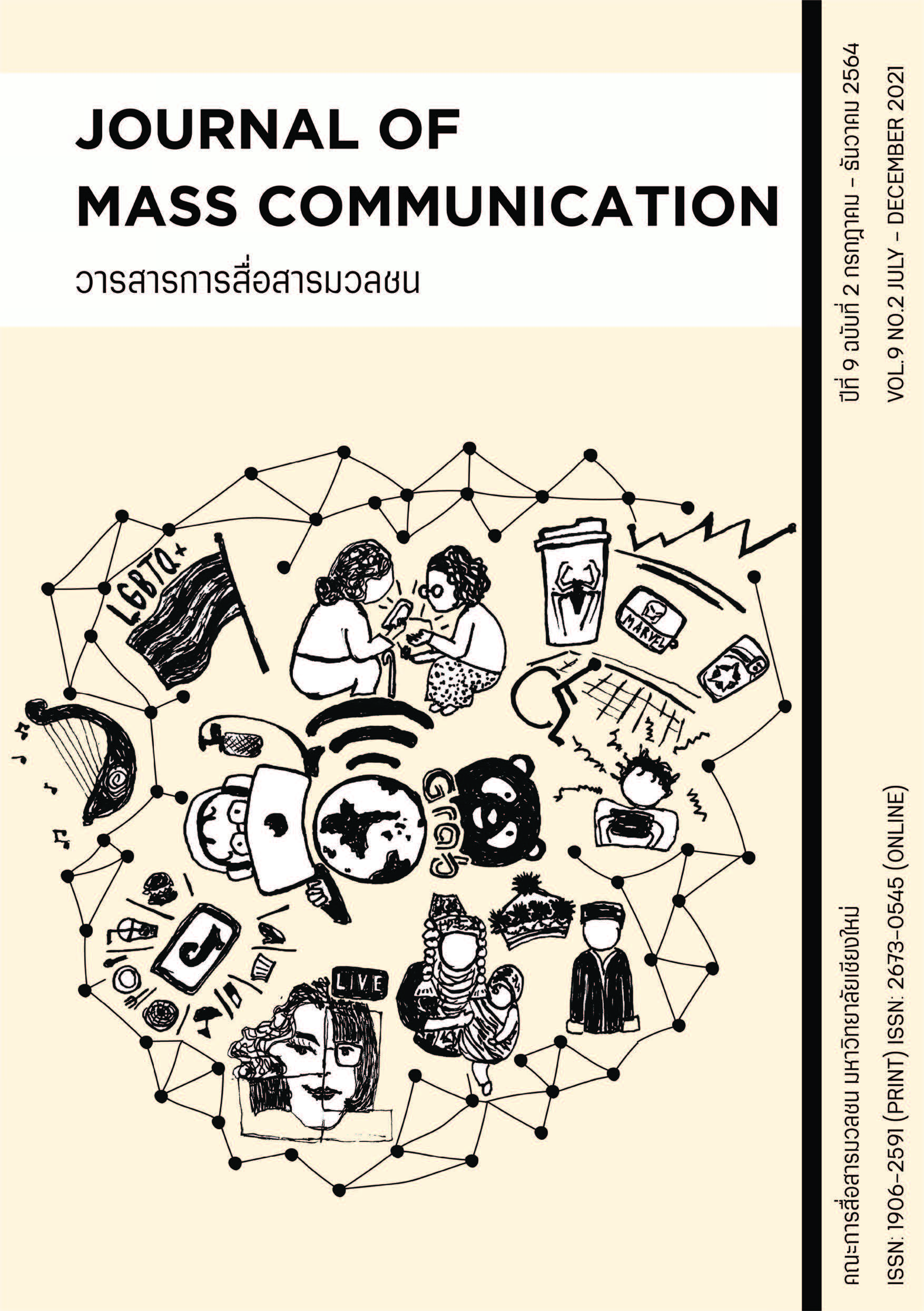การสื่อสารผ่านบทเพลงความเป็นชาติพันธุ์และวัฒนธรรมที่เกี่ยวข้องกับเพลงของชาวปกาเกอะญอ “เพลงเก่อตอเก” ในตำบลสันพระเนตร อำเภอสันทราย จังหวัดเชียงใหม่
Main Article Content
บทคัดย่อ
งานวิจัยชิ้นนี้มีวัตถุประสงค์ คือ 1) เพื่อวิเคราะห์เนื้อหาเพลงความเป็นชาติพันธุ์ของชาวปกาเกอะญอ และ 2) เพื่อศึกษาวัฒนธรรมที่เกี่ยวข้องกับเพลงในสังคมความเป็นชาติพันธุ์ชาวปกาเกอะญอ ตำบลสันพระเนตร อำเภอสันทราย จังหวัดเชียงใหม่ โดยใช้ระเบียบวิธีวิจัยเชิงคุณภาพ โดยการเก็บรวมรวมข้อมูลจากการวิเคราะห์เอกสารที่มีเนื้อหาเพลงชาวปกาเกอะญอ “เก่อตอเก” และการสัมภาษณ์แบบกึ่งโครงสร้าง โดยเลือกผู้ให้ข้อมูลสำคัญแบบเจาะจง รวมถึงการสังเกตแบบมีส่วนร่วม วิเคราะห์ข้อมูลด้วยการวิเคราะห์เนื้อหาบทเพลง และการวิเคราะห์ข้อมูลจากผู้ให้ข้อมูล
ผลการวิจัยพบว่า ในส่วนเนื้อหาเพลงความเป็นชาติพันธุ์ของชาวปกาเกอะญอในเพลง “เก่อตอเก” พบว่า 1) เนื้อหาของบทเพลงได้กล่าวถึงลักษณะพื้นถิ่นที่อยู่อาศัย มรดกที่ชาวปกาเกอะญอต้องช่วยกันเก็บรักษา ดูแลไม่ให้สูญหาย การอนุรักษ์การละเล่นของชาวปกาเกอะญอ เครื่องดนตรี ภาษา การสื่อสารภาษาความเป็นชาติพันธุ์ของชาวปกาเกอะญอ รวมถึงการแต่งกายที่แสดงออกถึงความชาติพันธุ์ในลักษณะสีดำและสีขาว การสวมเสื้อผ้าปกาเกอะญอเพื่อไปพบปะเพื่อนที่เป็นกลุ่มชาติพันธุ์ปกาเกอะญอด้วยกัน 2) วัฒนธรรมที่เกี่ยวข้องกับกับดนตรี เพลงของชาวปกาเกอะญอ พบว่า วัฒนธรรมของชาวปกาเกอะญจะอยู่ในรูปแบบของการประกอบพิธีกรรมต่าง ๆ ได้แก่ การทำพิธีกรรมเลี้ยงผี บวงสรวงดวงวิญญาณ ด้วยการต้มเหล้า ฆ่าไก่-แกง และมัดมือผู้ร่วมพิธีด้วยฝ้ายดิบ ซึ่งเกี่ยวโยงกันกับประระเพณีปีใหม่ อยู่ในการละเล่นของชาวปกาเกอะญอที่นิยม ได้แก่ การร้องเพลงกระโดดไม้ไผ่ โดยมีเครื่องดนตรีที่ใช้ในการบรรเลงเพลง ได้แก่ “เตหน่า” ที่ใช้ในพิธีกรรมสำคัญ ๆ กิจกรรมยามว่าง และเพื่อความสนุกสนาน
Article Details

อนุญาตภายใต้เงื่อนไข Creative Commons Attribution-NonCommercial-NoDerivatives 4.0 International License.
ลิขสิทธ์ที่ผู้เขียนบทความต้องยอมรับ
เอกสารอ้างอิง
กาญจนา อินทรสุนานนท์. (2553). กะเหรี่ยงโป. มหาสารคาม: สถาบันวิจัยและพัฒนาศิลปะและวัฒนธรรมภาคอีสาน มหาวิทยาลัยมหาสารคาม.
โกวิท แก้วสุวรรณ. (2542). “ดุทูหล่า” ในพิธีเรียกวีหล่าของชาวกะเหรี่ยงโป: กรณีศึกษากระเหรี่ยงโป บ้านเกาะสะเดิ่ง ตำบลไล่โว่ อำเภอสังขละบุรี จังหวัดกาญจนบุรี. นครปฐม: มหาวิทยาลัยมหิดล.
ขจร ฝ่ายเทศ. (2548). การสื่อสารทางการเมืองในเพลงไทยลูกทุ่ง พ.ศ.2507-2547. กรุงเทพฯ: คณะวารสารศาสตร์และสื่อสารมวลชน มหาวิทยาลัยธรรมศาสตร์.
จุมพล หนิมพานิช. (2550). การวิจัยเชิงคุณภาพในทางรัฐศาสตร์และรัฐประศาสนศาสตร์. กรุงเทพฯ: สำนักพิมพ์แห่งจุฬาลงกรณ์มหาวิทยาลัย.
ฉวีวรรณ ประจวบเหมาะ. (2549). รัฐชาติและชาติพันธุ์: การจำแนกกลุ่มชาติพันธุ์ ปัญหา และข้อเสนอแนะ. กรุงเทพฯ: สำนักงานส่งเสริมและสนับสนุนทางวิชาการ กรมพัฒนาสังคมและสวัสดิการ กระทรวงพัฒนาสังคมและทรัพยากรมนุษย์.
ชมพูนุท นุตาคม. (2545). สถานภาพ บทบาทและแนวโน้มการประชาสัมพันธ์ของหน่วยงาน ราชการและรัฐวิสาหกิจในยุคสารสนเทศ. กรุงเทพฯ: มหาวิทยาลัยราชภัฏสวนดุสิต.
ชนัตว์ ชามทอง. (2550) การจัดกิจกรรมสร้างเสริมความสามารถ ด้านการสื่อสารทางวิทยาศาสตร์ สำหรับนักเรียนช่วงชั้นที่ 3. มหาวิทยาลัยเชียงใหม่.
เฌอมาลย์ ราชภัณฑารักษ์ และพวงเพชร สุรัตนกวีกุล. (2544). มนุษย์กับสังคม. พิมพ์ครั้งที่ 3 กรุงเทพฯ: สำนักพิมพ์มหาวิทยาลัยเกษตรศาสตร์.
ฐาปกรณ์ กระแสทิพย์ และกิตติ กันภัย. (2554). การสื่อสารผ่านบทเพลงของคริสต์ศาสนานิกายโปรเตสแตนต์ในประเทศไทย. (วิทยานิพนธ์ปริญญานิเทศศาสตรมหาบัณฑิต). จุฬาลงกรณ์มหาวิทยาลัย. กรุงเทพฯ.
ณรงค์ชัย ปิฎกรัชต์, นิรันดร์ ภัคดี และ เอกราช แพรม่วง. (2542). ดนตรีของชนเผ่ากะเหรี่ยงสะกอในพื้นที่มูเส่คี. กรุงเทพฯ, วิทยาลัยดุริยางคศิลป์ มหาวิทยาลัยมหิดล.
ณรงค์ชัย ปิฎกรัชต์, ปราโมทย์ ด่านประดิษฐ์ และ ศรีจันทร์ น้อยสะอาด. (2542). แกงของชนเผ่าปากาเกอญอ อำเภอแม่แจ่ม จังหวัดเชียงใหม่. นครปฐม: วิทยาลัยดุริยางคศิลป์ มหาวิทยาลัยมหิดล.
พิชิต แก้วก๋อง. (2549). การพัฒนากิจกรรมการเรียนการสอนเพื่อส่งเสริมทักษะการแก้ปัญหา และการสื่อสารทางคณิตศาสตร์ สำหรับนักเรียนมัธยมศึกษาปีที่ 2 โรงเรียนสันหนองควาย จังหวัดเชียงราย. มหาวิทยาลัยเชียงใหม่.
ราชบัณฑิตสถาน. (2563). พจนานุกรมฉบับราชบัณฑิตยสถาน พุทธศักราช 2554. กรุงเทพฯ: อักษรเจริญทัศน์.
สุกัญญา สมไพบูลย์. (2559). กระบวนการผลิต การนำเสนอ และการสร้างความหมายเชิงสัญญะ ในรายการเดอะวอยซ์ไทยแลนด์. วารสารนิเทศศาสตร์, 34(2), พฤษภาคม-สิงหาคม 2259, 71-90.
สุกรี เจริญสุข. (2538). ดนตรีชาวสยาม. กรุงเทพฯ: Dr.Sax.
สุเทพ สุนทรเภสัช. (2548). ชาติพันธุ์สัมพันธ์: แนวคิดพื้นฐานทางมานุษยวิทยาในการศึกษาอัตลักษณ์ กลุ่มชาติพันธุ์ ประชาชาติ และการจัดองค์กรความสัมพันธ์ทางชาติพันธุ์. กรุงเทพฯ: เมืองโบราณ.
สุวิชาน พัฒนาไพรวัลย์. (2556). จงดูแลรักษาไว้. เชียงใหม่: ลานนา มีเดีย แอนด์ โปรดักชั่น.
สำนักงานวัฒนธรรมจังหวัดเชียงราย. (ม.ป.ป.). เสน่ห์เชียงรายหลากหลายชาติพันธุ์. ออนไลน์ https://www.m-culture.go.th/chiangrai/article_attach/article_fileattach_20161103104554.pdf. สืบค้นเมื่อ 26 พฤศจิกายน 2563.
อรอำไพ ศรีวิชัย. (2555). การสร้างชุดกิจกรรมเพื่อส่งเสริมทักษะการสื่อสารทางคณิตศาสตร์ สำหรับนักเรียนชั้นมัธยมศึกษาปีที่ 3 โรงเรียนบ้านเวียงฝาง. วิทยานิพนธ์ศึกษาศาสตรมหาบัณฑิต สาขาวิชาคณิตศาสตร์ศึกษา บัณฑิตวิทยาลัย มหาวิทยาลัยเชียงใหม่.
อานันท์ กาญจนพันธุ์. (2553). ทฤษฎีและวิธีวิทยาของการวิจัยวัฒนธรรม: การทะลุกรอบและกับดักของความคิดแบบคู่ตรงข้าม. กรุงเทพฯ: อมรินทร์บุ๊คเซ็นเตอร์.
อัมรา พงศาพิชญ์. (2537). วัฒนธรรม ศาสนา และชาติพันธุ์: วิเคราะห์สังคมไทยแนวมานุษยวิทยา. กรุงเทพฯ: จุฬาลงกรณ์มหาวิทยาลัย.
โอชิ จ่อวาลู. (2561). เตหน่า พิณโบราณในนิทานปกาเกอะญอที่กลายเป็นเครื่องมือสื่อสารเรื่องชาติพันธุ์ในเวทีโลก. ออนไลน์ https://readthecloud.co/lazy-man-pwa-ka-nyaw-lute/. สืบค้นเมื่อ 20 ตุลาคม 2563.
TK park. (ม.ป.ป.). เตหน่า. ออนไลน์ shorturl.asia/3K4jx. สืบค้นเมื่อ 25 ตุลาคม 2563.
Carl I. Hovland, IrvinG L. Janis, and Harold H. Kelly. (1953). Communication and Persuasion. New Haven: Yale University Press, p.12.
Warren W. Weaver in Claude E. Shanon and Warren W. Weave. (1949). The Mathematical Theory of Communication. Urbana, III : University of Illinois Press, p.95.


